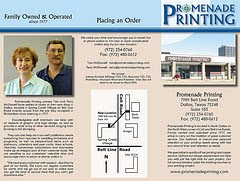by Carol Tice
I’ve frequently discussed the virtues of adding some copywriting to your freelance-writing mix. But, many writers ask, how do I get started as a copywriter? Most copywriters break in by writing for a small, local business in their town.
The good news: Small businesses that need marketing help are everywhere.
Here are 10 ways to find your first business writing assignments:
1) Friends and family. Tell everyone you know you’re available to write for businesses. Let them know the types of copywriting work that interest you, whether it’s brochures, white papers, direct mail sales letters, or Web content.
2) Businesses you patronize. As you go about your daily life, you interact with many small businesses. You see a chiropractor, shop at a local organic grocer, or take your kids to a gym. These are all natural places for you to connect with business owners. Your secret weapon-you already know and like the business! You could also do a barter deal for writing work since you’re already a customer.
3) Your local downtown. Walk the business district of your neighborhood or visit the local chamber of commerce and pick up all their current brochures or fliers. Call or stop in at the ones that have weak marketing materials, introduce yourself as a copywriter, and ask if they’d like help creating more powerful messages.
4) Your local business park. Companies in industrial parks tend to be medium-sized or bigger, and in fairly low-glamour businesses — meaning they’re prime copywriting targets. They need to get out the word, as they don’t have a shop on Main Street customers can see. Also, they tend to get hit up less, so the competition isn’t as stiff. Before you knock on doors and introduce yourself, drive through once and write down all the company names. Go home and look at their Web sites (or discover they don’t have one), so you have something to talk about when you come back and try to meet the business owners.
5) Business networking events. Wherever large groups of business owners gather in your town-the local Chamber luncheon, weekly networking group, LinkedIn meetup, or whatever-you want to be there.
6) Social media. Work your networks and online forums and let them know you’re open for copywriting work. Find prospect companies and follow them — strike up a conversation, study their Web site, maybe provide some useful marketing-article links, then make your pitch. Use your blog to discuss your quest for copywriting work. Try InMail on LinkedIn — LI reports it has an impressive 30 percent response rate.
7) In niche industries you know. This is an easy way to identify prospects, particularly if you’re looking for work blogging or writing other online content. If you have an area of expertise, look at the Web sites of all the local businesses in that niche. Then call the companies with the worst Web sites and mention the most glaring omission in their marketing plan — might they need a blog, a white paper, case studies?
8. Through content-site profiles. While I don’t recommend trying to earn by bidding on projects on content sites such as Elance or Guru.com, it can be worthwhile to leave a profile on these heavily-trafficked sites. Small businesses looking for writers do scan these sites, and may find you and approach you off the site and hire you. I recently went on an interview to ghost a CEO’s book, and the company found me through an old Guru profile I’d forgotten all about!
9) At print publications. Magazines’ article assignments are often the tip of an iceberg at a publisher. There may be opportunities to write advertorial articles for the magazine’s advertisers, or to create special advertising sections. They may put on conferences that need marketing materials, or have a “custom publishing” arm that helps companies create training courses or books that commemorate company milestones.
10) By creating a sample. If you’re really stuck for a first client, create a marketing piece about your copywriting services. You can then use this as a mailer to send to prospects. Having a sample in front of them should help you sign up that first client. Personally, when I broke into copywriting in 2005, I used a variant of #2. I called on companies I had written about in my staff-writing job at a business journal to let them know I was leaving the paper. (Many folks do this when they leave a company to freelance, by turning around and freelancing for their former employer.) One of them asked me to ghost his blog and write advertorial articles for the company’s Web site. I made several thousand dollars over a few months’ time, and I was on my way.
If you’ve done copywriting, how did you first break in? Leave a comment and tell us about it.
This post originally appeared on the WM Freelance Writer’s Connection.
Photo via Flickr user ruthieonart











